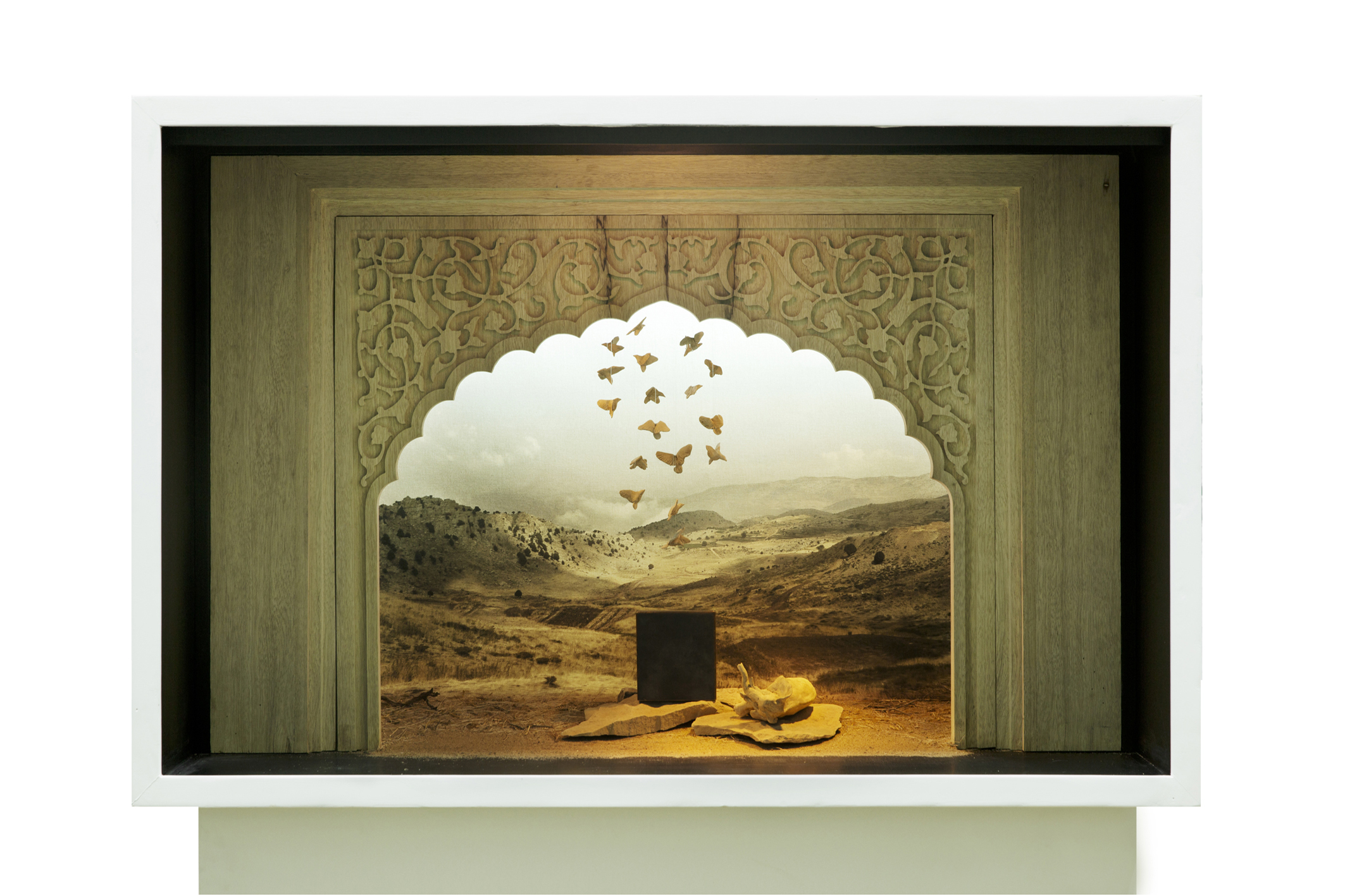
Randa Mirza. The Year of the Elephant, 2014. Selection from the series, El-Zohra Was Not Born in a Day. Diorama with mixed media, 105cm x 70cm x 75 cm. Courtesy of the artist and Galerie Tanit (Munich/Beirut). © Randa Mirza.
Imagine a sky full of birds. But these are not ordinary birds: these birds carry rocks, and the rocks are on fire. These extraordinary birds use their fiery stones to repel the army of an enemy encroaching on a sacred space. Over many centuries, the birds of this myth have been imagined as the heroes of the religion of Islam. Narratives such as this are the subjects of a series, El-Zohra Was Not Born in a Day, by the Lebanese artist Randa Mirza. Using a contemporary and personal voice, Mirza retells ancient Arabian stories that have been obscured over time and muted by outside forces.
The Year of the Elephant is the first of seven works in Mirza’s series, and the story corresponds to a historical event. In 570 BCE, the Christian king of Yemen, Abraha, attempted to attack Mecca. Abraha had built a new church with the hope of diverting the pilgrimage from the Kaaba—a highly sacred site for Muslims—in Mecca to his cathedral. When his efforts failed, Abraha decided to destroy the Kaaba. An elephant, an unknown animal to ancient Arabs, was used to lead the army from Yemen to Mecca and to incite fear. But, approaching the Kaaba, the elephant refused to advance, and birds dropped burning stones onto Abraha’s army. The elephant was unharmed, and the Kaaba was saved.
Interpreting this story in a diorama, Mirza explores how myths exist at the intersection of history, fiction, philosophy, and poetry. Mirza’s work upends the power of the characters. In her depiction, the protagonists are the elephant, the Kaaba, and the swarm of birds attacking from the blazing sky; the presence of humans, Abraha and his army, has been removed. Without human characters, the diorama is imbued with a sense of timelessness; the event could belong to the past, future, or possibly both.
This story is also retold in the Quran, in the “Elephant” chapter (surah); according to Muslim tradition, when the Prophet Muhammad was asked when he was born, he replied, “in the year of the elephant.” Fragments of this story are found elsewhere in the Quran, and the story is embedded in the collective consciousness of Middle Eastern cultures, but the historical account cannot be separated from the mythology.

Randa Mirza. Allat, 2015. Selection from the series, El-Zohra Was Not Born in a Day. White marble sculpture, 21cm x 21cm x 21cm; Installation: 160cm x 50cm x 50cm. Courtesy of the artist and Galerie Tanit (Munich/Beirut). © Randa Mirza.
For Mirza, mythology and history are entwined. She said, “I think that mythology is the truth: It’s a coded truth that has lost its origin. If you have the codes, then you will understand what happened. But we never will.”1 Mirza believes that a contemporary audience can reread and analyze these narratives, but pieces will always be missing. Recreating these myths is a way for Mirza to tell the stories of her culture and reveal details of the past that were shrouded in the collective memory. These stories, even undeciphered versions, evince the imagination and creativity of an ancient people.
While the myths can never be completely understood, Mirza believes that these stories can inspire another form of understanding. “These myths show that Arab and Muslim culture is much richer than the caricature that has been portrayed in the media,” Mirza explained. These stories delve into obscure parts of history, and they present a view of the culture before it was censored. The systems of colonialism, Orientalism, totalitarianism, and institutional religions—both Islam and Christianity—removed ancient ideas or memories of events that countered the newer beliefs. Mirza believes that these venerable myths confront the forces that combined to suppress a complex view of a people.
El-Zohra Was Not Born in a Day includes other stories, such as those of Issaf and Naila, of Venus and the fallen angels Harut and Marut, and of Allat. Stressing her postcolonial perspective, Mirza has recreated each of these stories through sculptures and miniature dioramas. In November 2016, the series will be shown at Galerie Tanit in Beirut, where viewers can witness a goddess transformed into a planet, two lovers turned to stone, a white moon goddess, and birds in a burning sky.
Randa Mirza (born 1978, Lebanon) is a visual artist and photographer. Her work as a photographer has received numerous prizes, including the “No Limit” award at the festival Les Rencontres Photographiques d’Arles (2006). Selected venues for solo shows include the Finnish Museum of Photography, Helsinki, Finland; Sfeir-Semler Gallery, Hamburg, Germany; and Galerie Tanit, Beirut, Lebanon. Her series, El-Zohra Was Not Born in a Day, was awarded a grant from the Arab Fund for Arts and Culture. Mirza has been an artist-in-residence at the Nordic Institute for Contemporary Arts and Helsinki International Artist Programme (HIAP), Helsinki, Finland; and Fondazione Bevilaqua La Masa, Venice, Italy. Mirza lives in Beirut and Marseille.
1. From a conversation with the author via Skype, April 17, 2016.



